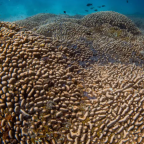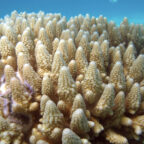
Broken fragments of coral reef may look like nothing more than litter on the beach or seafloor, but coral rubble can support more animals than living corals, according to researchers at the University of Queensland.
Study lead author Dr. Kenny Wolfe said that reef rubble habitat, which is often overlooked as desolate, unattractive, and “dead,” is very much alive.
“When people think of coral reefs they often think of larger invertebrates that are easily found, such as sea cucumbers, starfish and giant clams,” said Dr. Wolfe. “But interestingly, dead coral rubble supports more of what we call ‘cryptic’ animals than live coral.”
“Cryptic animals are simply hidden creatures, that include tiny crabs, fishes, snails and worms – all of which hide in the nooks and crannies of the reef to avoid predation.”
“And just like on land with small insects and bugs, biodiversity in the sea can be dominated by these tiny invertebrates.”
Since cryptic animals are masters at hiding, they are not always easy to locate and study. The
UQ researchers designed 3D-printed coral stacks called RUBS (RUbble Biodiversity Samplers) to survey cryptic animals on coral reefs.
The 3D-printed structures resemble the surrounding reef rubble so that it can lure cryptic reef organisms to be unknowingly monitored.
“Every piece of coral or rubble is different,” said Dr. Wolfe. “RUBS provide a uniform method to survey the hidden majority on coral reefs.”
“By sampling the RUBS’ structures over time, the team were able to identify changes in the cryptic population, adding pieces to the puzzle and filling in the unknowns of coral reef food webs.”
“This data fills important knowledge gaps, such as how small cryptic animals support coral reefs from the bottom of the food chain, all the way up to bigger predators.”
According to Dr. Wolfe, this approach to surveying corals represents a new step in understanding corals, whether they are considered dead or alive.
“We’re really pulling back the curtain on just how alive these ‘degraded’ reefs are. These are important habitats, which support coral reef biodiversity and important food webs.”
“This new technology is a new opportunity for reef management, particularly for reef education and awareness. We’re excited to learn about and celebrate the diversity of life in this misunderstood habitat.”
The study is published in the journal Methods in Ecology and Evolution .














Social Profiles